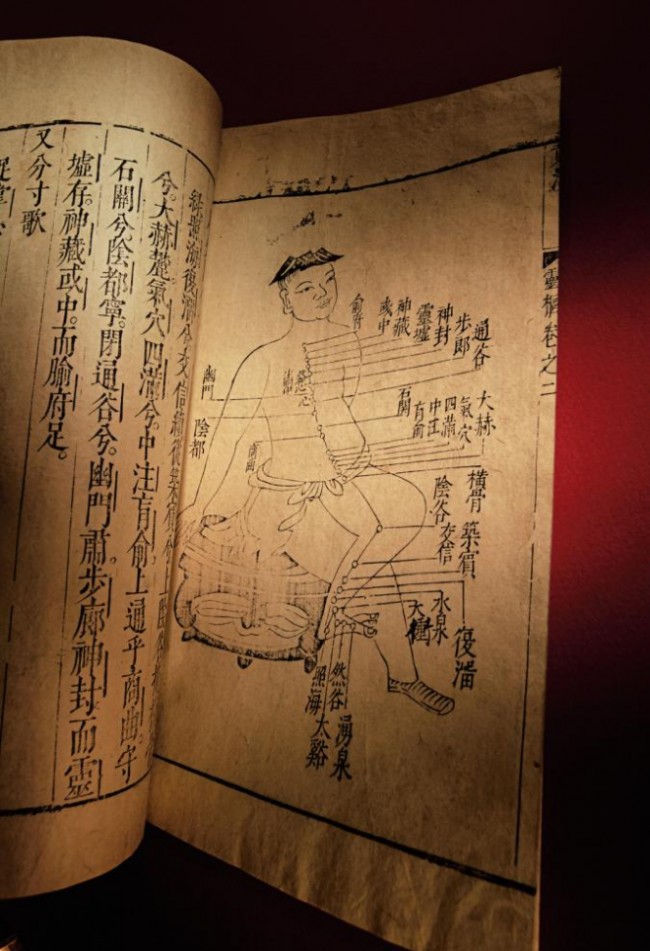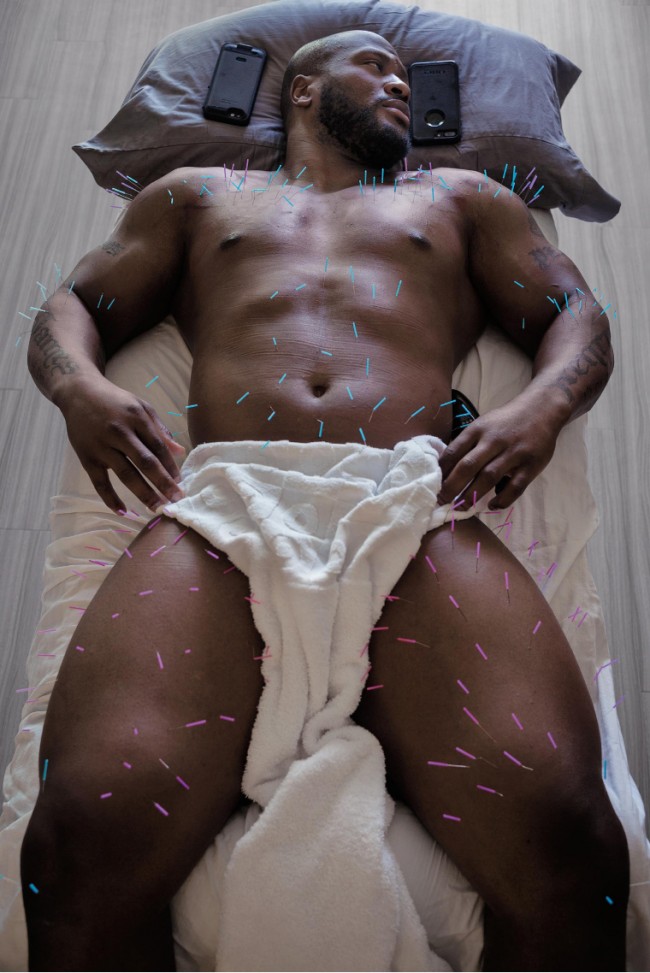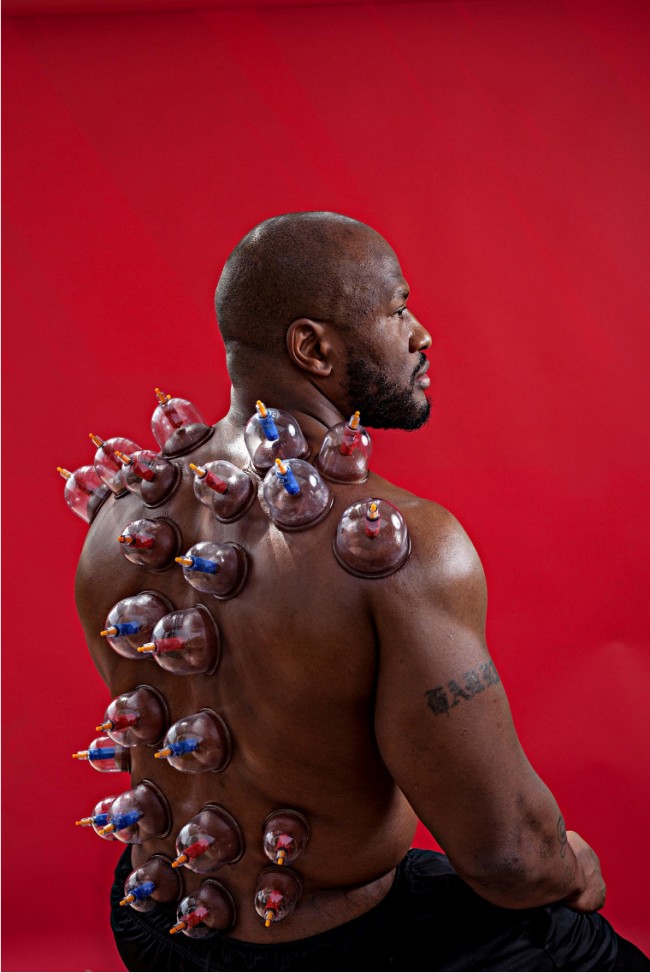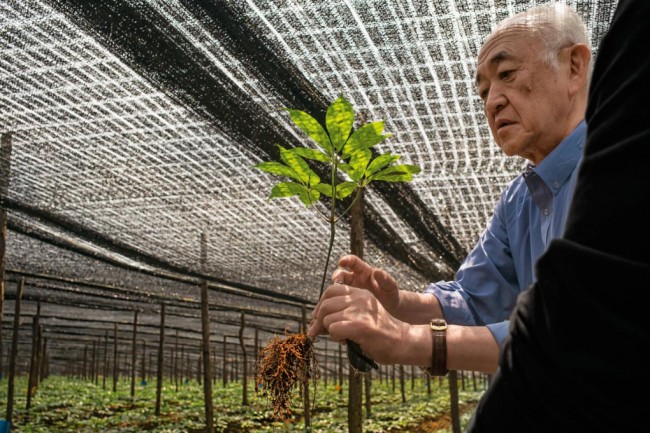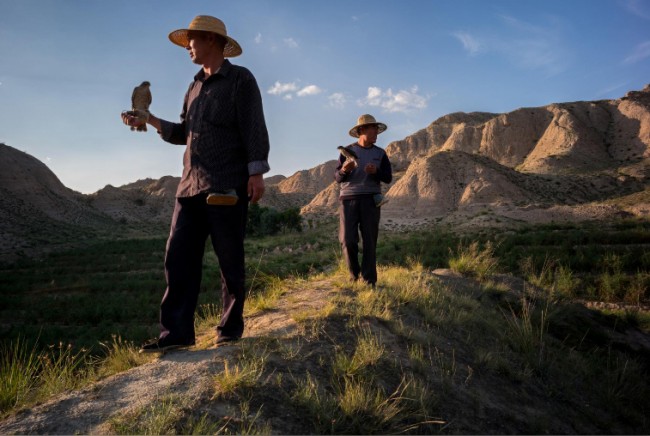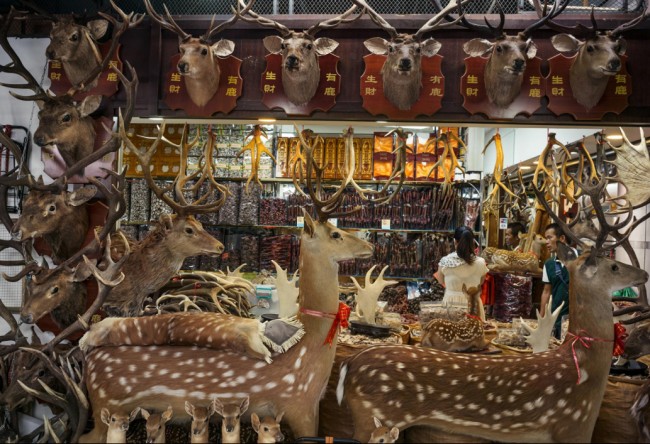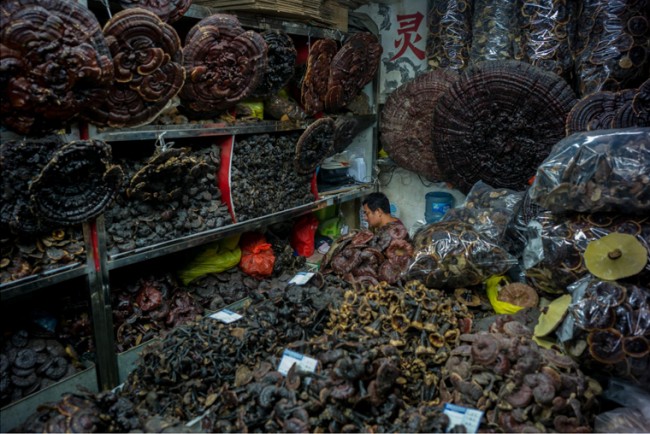동향분석
Home > 뉴스브리핑센터 > 동향분석| [동향분석] How ancient remedies are changing modern medicine (1) |
|
How ancient remedies are changing modern medicine (1) By Peter Gwin / Photographs by Fritz Hoffmann
This 1620 version of The Yellow Emperor’s Classic of Internal Medicine, first compiled some 2,100 years ago, includes a map of qi lines and acupuncture points. Acupuncture remains a contentious subject among Western doctors, though many agree it’s effective at treating some symptoms. In my hand I’m holding a warm, beating heart. About the size of a softball, it’s a luminous globe of scarlet, pink, and white tissue. I can feel its chambers contracting and hear the whoosh of the fluid it’s still pumping. It’s slimy and gives off a slightly pungent odor. The organ is alive almost eight hours after I watched Paul Iaizzo remove it from a sedated pig in a basement lab, connect it to tubes simulating arteries and veins, and spark it back into rhythm with an electric jolt, as a paramedic would shock a human heart back to life. Although it’s outside the pig’s body, the heart flexes and lurches on its own, driven by some unseen, unexplained, primordial force. More than grotesque, I find it hypnotic and beautiful. The pig’s heart is still beating partly because Iaizzo, a professor of surgery at the University of Minnesota, treated it with a bath of chemicals mimicking those in bile from bears. It’s a scientific application of a belief Chinese healers espoused as far back as the eighth century: Bear bile can benefit the human body. A robust market for bear bile still exists. In Asia bears are farmed for their bile, kept alive in small cages, with catheters inserted to drain their fluids. Animal welfare groups decry the practice, which is inarguably inhumane. And yet, as I hold the beating pig heart and listen to Iaizzo describe how the chemicals that protect a bear’s organs from atrophying during hibernation could also sustain human organs, I can’t help but wonder whether bear bile could have saved my father’s failing heart, or whether someday it might save mine, or my children’s. Few subjects ignite more heated debate in health circles than traditional Chinese medicine. It’s further complicated by the work of researchers like Iaizzo and many others who are looking at traditional cures through the lens of cutting-edge science and finding some interesting surprises—surprises that could have profound impacts on modern medicine. Cultures from the Arctic to the Amazon and Siberia to the South Pacific have developed their own medicine chests of traditional cures. But China, with one of the oldest continuous accumulations of documented medical observations, offers the biggest trove for scientists to sift through. The Chinese record dates back to the third century B.C., when healers began analyzing the body, interpreting its functions, and describing its reactions to various treatments, including herbal remedies, massage, and acupuncture. For more than 2,200 years, generations of scholars added to and refined the knowledge. The result is a canon of literature dealing with every sort of health problem, including the common cold, venereal disease, paralysis, and epilepsy. This knowledge is contained in books and manuscripts bearing such enigmatic titles as The Pulse Classic (third century), Prescriptions Worth a Thousand Pieces of Gold (seventh century), and Essential Secrets From Outside the Metropolis (eighth century).
James Harrison relied on a form of acupuncture and other Chinese therapies to help him recover from pain and soreness during his 16-year NFL career. “If it makes me feel good,” the recently retired player says, “I don’t need no scientific proof.”
After a weightlifting workout, Harrison received a Chinese cupping treatment, in which a therapist uses suction to attach plastic cups to the skin. In recent years many athletes and trainers have embraced the therapy as a way to reduce inflammation, increase blood flow, and perform a type of deep tissue massage. Traditional medicine remained the primary form of health care in China until the early 20th century, when the last Qing emperor was overthrown by Sun Yat-sen, a Western-trained doctor who promoted science-based medicine. Today Chinese physicians are trained and licensed according to state-of-the-art medical practices. Yet traditional medicine remains a vibrant part of the state health care system. Most Chinese hospitals have a ward devoted to ancient cures. Citing traditional medicine’s potential to lower costs and yield innovative treatments, not to mention raise China’s prestige, President Xi Jinping has made it a key part of the country’s health policy. He has called the 21st century a new golden age for traditional medicine. From a research perspective, it very well may be a golden age. Scientists from leading universities in the United States and Europe, including UCLA, Duke, and Oxford, as well as many in Asia, are looking at the scientific underpinnings of some traditional treatments for diseases such as cancer, diabetes, and Parkinson’s. But the practice of melding the modern with the traditional is also spreading among health care consumers. When they don’t find relief from Western medicine, Americans increasingly are turning to traditional treatments, notably acupuncture, which is now covered by some health insurance plans, and cupping, a muscle therapy that involves suction and is endorsed by many professional athletes. The internet has fostered the growth in herbal remedies, which are often cheaper than doctor-prescribed pharmaceuticals. A patient can read about a traditional remedy online, order the herbs on Amazon, and watch YouTube videos on how to prepare them at home. The result is a growing alternative health sector, which in 2017 saw U.S. herbal supplement sales top eight billion dollars, a 68 percent increase since 2008.
Yale University professor Yung-Chi Cheng examines a notoginseng plant at a research center in China’s Yunnan Province. Cheng is researching herbal treatments based on ancient Chinese formulas, including a cancer treatment that is currently in drug trials. You’ll also find doctors who denounce traditional Chinese medicine as pseudoscience and quackery, pointing to some of its most outlandish claims, like the ancient practice of prescribing firecrackers to chase away demons, or mysterious concepts still embraced, such as a nebulous life force called qi (a term translated literally as “the steam that rises from the rice”). Others rail against its use of animal parts and warn against the potential dangers of its herbal formulas. “Rarely do you find anyone who looks at it objectively,” says medical historian Paul Unschuld. A leading authority on the history of Chinese medicine—and often an unsparing critic of the way it’s interpreted—he has collected and translated hundreds of ancient medical texts and is working with a Chinese-German startup to study them for ideas about treating a variety of illnesses, including epilepsy. “People generally see only what they want to see,” he says, “and fail to fully examine its merits and its faults.” I encountered this hornet’s nest firsthand when I wrote a story about rhinos being poached for their horns. According to ancient Chinese formulas, rhino horn can be used to treat fever and headaches. In Vietnam I found patients using it to treat hangovers and the side effects of chemotherapy. Multiple scientific studies have determined that rhino horn, which is made of keratin (the same substance as human fingernails), induces little to no discernible pharmacological effects when ingested. But some patients using rhino horn may find relief because of the placebo effect. After the story was published, I got letters from readers angrily denouncing Chinese medicine as “ignorant,” “cruel,” and akin to “witchcraft.” Such criticisms aren’t without merit. Rhino horn sales in Asia are a primary factor pushing rhino populations toward extinction. In addition to bears, many other animals—including several threatened species such as tigers, leopards, and elephants—are poached in the wild or farmed for their parts. But modern medicine has its own controversial practices. The effectiveness of many popular antidepressant drugs remains hotly debated, with some studies showing they are barely more effective than placebos. Yet these drugs are extensively marketed and widely prescribed by physicians, generating billions of dollars in revenue. (This isn’t to say depression drugs don’t work. If a patient’s symptoms are relieved, then one can argue they work. But the chemicals in the pills themselves may not always be the source of the relief, just like the chemicals in rhino horn aren’t necessarily the source of relief for patients who take it.) When considered alongside other notable examples—the overprescription of opioids, doctor-endorsed fad diets, and questionable surgeries—Western indignation over traditional Chinese medicine can seem more hypocritical than Hippocratic. This is where snake oil might offer some illumination. Long synonymous with swindling, snake oil actually refers to a traditional Chinese ointment derived from the fat of the Erabu sea snake. Historians believe that such ointments were introduced to the U.S. during the 1800s by Chinese immigrants building railroads, who used them to treat aching joints and muscles. The substance acquired its shady reputation when American hucksters began selling mineral oil as Chinese snake oil.
Goji berries, said to improve sleep and athletic performance, among other benefits, dry at a farm in Qinghai Province. Demand for the berries is pushing production into new farming areas, such as Qinghai in northwest China, where the berries grow larger. The potency of the berries can vary due to differences in the soil and climate.
Falconers with sparrow hawks survey fields of goji berry bushes in Qinghai, looking for birds feeding on the fruit during harvest. But here’s the rub: Studies have shown that fat in the Erabu sea snake, an ingredient in some traditional Chinese remedies, contains higher levels of omega-3 fatty acids than salmon. Omega-3s are known to reduce inflammation and harmful cholesterol, improve cognition, and help alleviate depression. They are now used in several skin care products. In the 2000s Japanese scientists fed Erabu fat to mice and observed that their ability to swim and to learn their way around mazes improved. “Don’t throw out the baby with the bath water,” Yung-Chi Cheng, a pharmacology professor at Yale School of Medicine, says with a chuckle. “People forget that one of the oldest, most effective, scientifically proven drugs came from traditional medicine—aspirin.” The ancient Egyptians used dried myrtle leaves to treat aches and pains, and Hippocrates, the fourth-century B.C. Greek physician, considered the father of Western medicine, prescribed an extract of willow bark for fevers. But it wasn’t until the 1800s that European scientists figured out that the active ingredient in both is salicylic acid and synthesized it. Today aspirin, at pennies a dose, is arguably the world’s most cost-effective drug. “It all started with people observing willow bark was effective and then using it to treat illness,” Cheng says. “In this case, science followed the medicine, not the other way around.” Aspirin is hardly the only case of a modern drug hiding among traditional treatments. In 1972, the year Cheng finished his Ph.D. in pharmacology at Brown University, a chemist in the People’s Republic of China named Tu Youyou announced the discovery of an antimalarial substance based on a Chinese medicinal herb mentioned in a fourth-century formula.
A shop at a market in Guangzhou, China, specializes in deer parts—including antlers, penises, and tendons—used in traditional formulas. One obstacle to acceptance of Chinese medicine in the West is the controversial use of animal parts. During the Vietnam War, Tu had been tapped to work on a secret military project to help the Vietcong combat malaria. The disease accounted for roughly half their casualties. Western health researchers were also trying to solve this problem, screening more than 200,000 compounds. But Tu wondered if an answer might lie in classical Chinese medical texts. She tested several plants related to fever and found a remedy based on a yellow-flowering herb called wormwood (Artemisia annua). The drug derived from her research, called artemisinin, has been credited with saving millions of lives and earned her the 2015 Nobel Prize for medicine. My nose is freaking out as I follow Cheng on a tour of his labyrinthine lab at Yale, where his team is analyzing the characteristics of a variety of herbs to investigate their medicinal value. Amid the sighs and gurgles of various chemical experiments, I catch whiffs of black pepper, rosemary, camphor, ginger, chili, cinnamon, and other scents I can’t identify. The back of my throat tingles. I think I might sneeze. I notice I’m hungry for Thai food. On his desk, Cheng has a bobblehead doll in his likeness. A gift from the staff, it depicts him in a suit rather than the slightly baggy sweaters he generally favors, but it captures his thoughtful demeanor, receding hair, and large earlobes, which according to Chinese tradition signify longevity. On first impression Cheng may seem like a stereotypical advocate for traditional Chinese medicine. Though he’s been in the United States for five decades since emigrating from Taiwan, he still speaks English with a strong accent, and at 74, he comes from a generation of Chinese that still has a deep attachment to many of the old traditions. “But I didn’t really know much about Chinese medicine,” he says, noting that as a child, his parents took him to doctors practicing science-based medicine.
Cheng has focused his research solidly in the realm of science, developing antiviral drugs for chronic diseases, such as hepatitis B. But he has also wondered whether there were other cures, based on herbs like wormwood, awaiting rediscovery. Now he’s found one that may prove a breakthrough in cancer treatment. He opens a jar and hands me a pinch of a powder—a mixture of four herbs he calls PHY906. “Taste it,” he says. I put a tiny bit on my tongue. It’s bitter, with hints of licorice. During the 1990s Cheng noted that many cancer patients stopped chemotherapy because of its side effects, including diarrhea and severe nausea. Patients who completed the full course of chemotherapy tended to live the longest, so curbing the side effects, Cheng reasoned, could increase life expectancy. He also knew that Chinese medicine had many herbal treatments for diarrhea and nausea.
Su Bo works at the shop he runs with his wife, selling high-priced fungi at the traditional medicine market in Chengdu, China. Certain types of fungi offer proven health benefits. Like many specialty shops in China, this one has been rebuilt in a massive complex—which raises the question of how much can the market bear.
At their home in Wenshan, a family sorts dried notoginseng flowers, a key and lucrative ingredient used in many herbal formulas. Because of the potential for profit, large companies have acquired much of the farmland in Wenshan and now employ organic methods to improve crop quality. His colleague Shwu-Huey Liu, an expert in pharmaceutical chemistry who’s fluent in classical Mandarin, searched the Yale library’s large collection of early Chinese medical texts. In an ancient book titled Treatise on Cold Damage, printed on slightly wrinkled bamboo paper, she found an 1,800-year-old recipe for a mixture of skullcap, licorice, peony, and Chinese date, described as a treatment for “diarrhea, abdominal pain, and scorching heat in the anus.” Cheng’s team began trying different blends of the herbal formula. Over the past 20 years, they have proceeded from tests on mice to patients undergoing cancer treatment, overseen by the National Cancer Institute. As Cheng had hoped, almost all the patients who took the herbal formula experienced relief from nausea and other gastrointestinal distress, but something else happened: Their tumors shrank faster than those of patients who hadn’t taken the herbal formula. “I didn’t expect that,” Cheng says. “So now the question is, Why?” Johnson & Johnson and Bristol-Myers Squibb, both major producers of cancer drugs, also would like to know the answer. At a pharmaceutical conference in Philadelphia, I listen as Cheng’s son Peikwen explains to representatives from those and other leading drug companies what is known about how PHY906 works. A Stanford University graduate who also has an MBA, Peikwen, 43, joined his father to form a company to market PHY906 and develop other herbal drugs. He’s dressed in a trim charcoal suit, and his fluency in Mandarin, medical terminology, and Silicon Valley argot equip him to bridge the worlds of Eastern and Western medicine and make him a persuasive advocate. |








